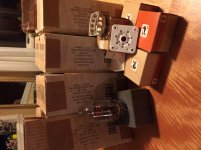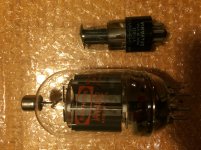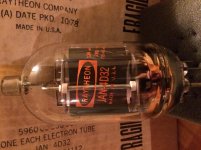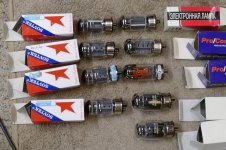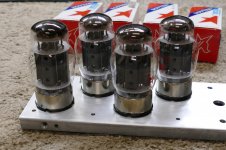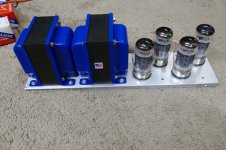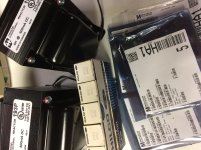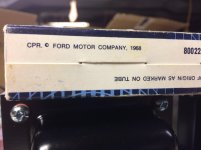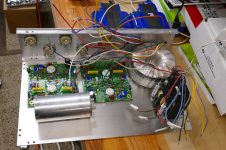Am I missing something or is the UPP going to be a lot more bang for buck.
There is (at least for now) no UPP amplifier, since Universal implies that it fits everything. These Universal Driver boards can DRIVE nearly everything, hence the name. They could be used to build an untold number of different push pull amplifier designs. This thread and some email requests seem to strongly favor a push pull amp using KT88's or 6550 tubes, so I will publish a "cookbook" design for these tubes and build an amplifier.
The driver boards alone do not make an amplifier. Some output tubes and a power supply are needed. These can be built using point to point wiring techniques, or made on PC board, and connected to the driver boards.
Along these lines, some "Amplifier Building Blocks" are being developed. There will be at least one power supply board capable of feeding several common amplifier designs. There will also be some universal output boards, for the common tube bases, octal, compactron, 9 pin Noval and Novar / Magnoval. Each board is jumper configurable for several different tube types. Prototypes exist for the output boards now, but changes are needed already, and more will be found as they get used for these experiments.
Any push pull amp will always be far cheaper than an SE amp of the same power because the OPT is much smaller physically. Iron and copper cost money. The OPT in an SE amp must be have an air gap in its core to deal with the DC current. This requires about 4 times the core size to get the same inductance as an ungapped core. Many audiophiles prefer the sound of a single ended amplifier, and will spend the extra money for that sound. I find that both the SE and the P-P amps have their unique advantages, and I have several of both types.
The SSE is a 15 WPC maximum Single Ended amplifier. The SPP is a 15 WPC Push Pull amplifier. The SPP is usually a lower cost build, again primarily due to the cost of the OPT's.
Building a higher power push pull amplifier using these boards will probably cost more than either the SSE or the SPP, again due to the cost of transformers, but also the tubes. A larger power transformer will be needed to feed a larger amplifier. A pair of cheap KT88's might be similar to the 4 EL84's used in the SPP, but you will need 4 KT88's or whatever tube you choose for the larger P-P amp and two driver tubes per channel for this amp. You can of course build anything from a 20 WPC amp to maybe 500 WPC with these boards. As in automobile engines, power costs money, how fast do you want to go?
judging from your post you are already having a lot of bang right now
Unfortunately, at the moment I am starting the process of doing my taxes. This means figuring out how much money Tubelab lost last year (currently adding up a large box of receipts), adding up a large box full of medical bills and receipts, then all the usual stuff before sending it all to the accountant, who figures it
Am I missing something or is the UPP going to be a lot more bang for buck.
There is (at least for now) no UPP amplifier, since Universal implies that it fits everything. These Universal Driver boards can DRIVE nearly everything, hence the name. They could be used to build an untold number of different push pull amplifier designs. This thread and some email requests seem to strongly favor a push pull amp using KT88's of 6550 tubes, so I will publish a "cookbook" design for these tubes.
The driver boards alone do not make an amplifier. Some output tubes and a power supply are needed. These can be built using point to point wiring techniques, or made on PC board, and connected to the driver boards.
Along these lines, some "Amplifier Building Blocks" are being developed. There will be at least one power supply board capable of feeding several common amplifier designs. There will be some universal output boards, for the common tube bases, octal, compactron, 9 pin Noval and Novar / Magnoval. Each board is jumper configurable for several different tube types. Prototypes exist for the output boards now, but changes are needed already, and more will be found as they get used for these experiments.
Any push pull amp will always be far cheaper than an SE amp of the same power because the OPT is much smaller physically. Iron and copper cost money. The OPT in an SE amp must be have an air gap in its core to deal with the DC current. This requires about 4 times the core size to get the same inductance an an ungapped core. Many audiophiles perfer the sound of a single ended amplifier, and will spend the extra money for that sound. I find that both the SE and the P-P amps have their unique advantages, and I have several of both types.
The SSE is a 15 WPC maximum Single Ended amplifier. The SPP is a 15 WPC Push Pull amplifier. The SPP is usually a lower cost build, again primarilly due to the cost of the OPT's.
Building a higher power push pull amplifier using these boards will probably cost more than either the SSE or the SPP, again due to the cost of transformers. A larger power transformer will be needed to feed a larger amplifier. Tubes are more money too. A pair of cheap KT88's might be similar to the 4 EL84's used in the SPP, but you will need 4 KT88's or whatever tube you choose for the larger P-P amp and two driver tubes per channel for this amp. You can of course build anything from a 20 WPC amp to maybe 500 WPC with these boards. As in automobile engines, power costs money, how fast do you want to go?
judging from your post you are already having a lot of bang right now
Unfortunately, at the moment I am starting the process of doing my taxes. This means figuring out how much money Tubelab lost last year (currently adding up a large box of receipts), adding up a large box full of medical bills and receipts, then all the usual stuff before sending it all to the accountant, who figures it all out and files it.
I did do a preliminary autopsy and it isn't pretty. I had my big power supply connected up since it's the only thing I currently have available that can feed a big amp. It is capable of 650 volts at 1.7 amps continuously.
It is however an old school 60Hz switcher with 1000 uF of output capacitance. This means it's reaction time is on the order of a half second. When an overload happens, the big caps dump their charge into the overload, then the feedback loop sees the voltage drop and dumps everything it has into recharging them, somewhere after the overload is on fire, the current limiting decides that something is wrong, and throttles back the power. The peak current seen during the initial overload is whatever 1000 uF charged to the output voltage is. Usually enough to blow parts and PC boards in half. Then the slow feedback loop will gyrate back and forth until an equilibrium is reached, or the overload condition is reduced to burnt parts.
In this case the arc was from a resistor connected from the plate of one output tube to the ground plating on one of the driver boards. The resistor no longer exists. Some of the ground plating on the PC board is gone, and there is a small carbonized crater burned nearly through the board. This means that the feedback connection on that board can not be trusted with high voltage unless that area can be drilled completely out of the board. I won't know that until I remove the board completely from the amp. The breadboard does still function and I get output from both channels with the feedback resistors disconnected. The channel that didn't fry still works good, but the fried channel is distorted.
The entire fury of the power supply was dumped into the OPT, and the fireball was on one plate lead. This means that the OPT ate all of what my power supply fed it, and probably has a really bad case of indigestion. The screwdriver confirms that it's core is severely magnetized. This can sometimes be fixed, sometimes not. Either way, I'm glad it was one of my $16 OPT's!
I probably won't get back to this until early next week.
I did some more digging through my tube collection and found two more boxes of "audio tubes." One box contained mostly every sort of 6L6 variant imaginable, even some cute blue ones called "blues tubes." I wonder what would happen if you fed them country music?
The other box? A matched quad of Sovtek KT88's, a pair of Chinese KT88's, matched quad of Valve Art EL34's, and several singles of different kinds of KT88's and 6550's.
With this many tubes, and almost unanimous requests for a KT88 amp, I guess that's what I will make. The TV tube amp is now on the back burner, slightly over cooked. OK, the fat tubes are almost touching, but I have several that have been on a diet, and enough spares to replace a set or two if they don't outlive me. I can always roast some 6L6 types in it if I get bored.
I have 8 and they all look to have their getter. If in the future I decide to use a different tube I can adjust a few voltages and change the output tube socket if needed.
My thought is to build an AB2 output stage following Raytheons recommended operating points. I am looking at the data sheet and have a question. This will be the first of many I'm sure.
Jack at Electra-print asks what is the desired current through each primary. The data sheep lists plate current at 365mA. This looks to be for two tubes. Do I ask for 365mA or half of this per side?
Here is a link to the data sheet. I can't attach it. Too big.
https://frank.pocnet.net/sheets/138/4/4D22.pdf
Electra-Print.com Push-Pull Output Transformers
Thanks for the help...I'm going to need a bit as this goes forward.
Evan
My thought is to build an AB2 output stage following Raytheons recommended operating points. I am looking at the data sheet and have a question. This will be the first of many I'm sure.
Jack at Electra-print asks what is the desired current through each primary. The data sheep lists plate current at 365mA. This looks to be for two tubes. Do I ask for 365mA or half of this per side?
Here is a link to the data sheet. I can't attach it. Too big.
https://frank.pocnet.net/sheets/138/4/4D22.pdf
Electra-Print.com Push-Pull Output Transformers
Thanks for the help...I'm going to need a bit as this goes forward.
Evan
Last edited:
I bought six, two were so bad that the getter spot was completely gone on one tube, and white on the other. I emailed the Ebay seller who replied that they were OK, just try them. I fired the white one up on a power supply and took a picture of the purple glow, which I sent to the vendor, and asked,"would you put this in YOUR Collins?" He replaced both tubes. I tested all six at the time, several years ago, but I will test each tube with a power supply again before connecting them to a good OPT.
The tube in Evan's picture looks good, but only powering up will tell.
I found two boxes of tubes that were purchased long ago. I walked into the warehouse of a popular tube seller 10 or 12 years ago. He asked if I was interested in any "pre-auditioned" Russian audio tubes. They all had the Tube Store matching stickers on them, and had been "used at a show." Considering the time frame, and the fact that most were 6L6 variants, it was likely NAMM. For $10 each, I took them ALL. I have stuck them in all sorts of amps, and never found a bad one, so these shapely Sovteks are going into the amp. The dates on the boxes are all from 2005.
The tube in Evan's picture looks good, but only powering up will tell.
I found two boxes of tubes that were purchased long ago. I walked into the warehouse of a popular tube seller 10 or 12 years ago. He asked if I was interested in any "pre-auditioned" Russian audio tubes. They all had the Tube Store matching stickers on them, and had been "used at a show." Considering the time frame, and the fact that most were 6L6 variants, it was likely NAMM. For $10 each, I took them ALL. I have stuck them in all sorts of amps, and never found a bad one, so these shapely Sovteks are going into the amp. The dates on the boxes are all from 2005.
Attachments
This looks to be for two tubes. Do I ask for 365mA or half of this per side?
The data sheet refers to the AVERAGE DC current drawn by the amp when delivering the rated power output. This is for two tubes, and roughly evenly split between the two tubes. Again, this is the average DC current. Peak AC currents will be much higher. I have always used half the DC current with some margin in picking OPT's, unless the transformer datasheet states otherwise.
Jack (Electra-Print) has strong opinions on how transformers should be made, so I would ask him since he is the person making the transformers. Include the tube datasheet in your email when you ask for a quote.
Continuing along and looking at parts on hand for 9 pin miniatures I have a bunch of 12au7 tubes. To my novice eye it looks like an OK fit.
It looks to me like the B+ for the driver board and the screen voltage called for in the 4d32 are the same 250 volts. Would it be OIK to power these off one supply. Linear or would a regulated supply be better? I have some high voltage regulator boards I could build up.
It looks to me like the B+ for the driver board and the screen voltage called for in the 4d32 are the same 250 volts. Would it be OIK to power these off one supply. Linear or would a regulated supply be better? I have some high voltage regulator boards I could build up.
Last edited:
The 12AU7 does not have a stellar reputation in the audio world. Much of that is noise, but some 12AU7's do indeed have a higher distortion than other similar tubes. In my testing I find that they are all over the place. One tube may work quite good, while an identical tube may exhibit high distortion. I have not tried any 12AU7's in this board. I did try some similar tubes (5963's) in the previous version of this board and they worked OK. My guess is that a 12AU7 may be OK for the first tube, but will not work too well in the second position due to the high voltages and signal levels involved.
The Driver board does not run on 250 volts in this application. I have not tested it below 350 volts, and that was when driving small tubes at low power (30 WPC and less). For the applications discussed so far in this thread I have run the driver board off of the main B+. It has been tested at 350 to just over 600 volts.
I will test the board at 650 volts next time I have a working setup. I have had it to 650 volts for short periods with no issues. The only things that might need changing is the dropping resistor for the first stage (500 volt cap after the resistor) and the plate load resistors on the second stage.
You will still need 250 volts or so for the screen grid. TV sweep tubes have a similar issue, except that they want 150 to 200 volts for the screen grid. I'm looking into a power supply that can generate all the voltages needed for these types of tubes.
The Driver board does not run on 250 volts in this application. I have not tested it below 350 volts, and that was when driving small tubes at low power (30 WPC and less). For the applications discussed so far in this thread I have run the driver board off of the main B+. It has been tested at 350 to just over 600 volts.
I will test the board at 650 volts next time I have a working setup. I have had it to 650 volts for short periods with no issues. The only things that might need changing is the dropping resistor for the first stage (500 volt cap after the resistor) and the plate load resistors on the second stage.
You will still need 250 volts or so for the screen grid. TV sweep tubes have a similar issue, except that they want 150 to 200 volts for the screen grid. I'm looking into a power supply that can generate all the voltages needed for these types of tubes.
I had some time today, but I found something more fun to do that fix a dead amp breadboard..........start building a new amp! Unfortunately my drill batteries died from use in zero degree F weather late last year. They were getting sick as I was using them, but I had hoped that they would recover. One wouldn't charge at all, and the other would drill one hole per charge. OK, they are 20 year old NiCd's.
I got the tube sockets and OPT's mounted. No wiring yet. This the divider that runs through the center of the chassis.
I got the tube sockets and OPT's mounted. No wiring yet. This the divider that runs through the center of the chassis.
Attachments
Not much activity in the past week, except for some test fitting. The OPT's and power toroid were stolen from the breadboard for mocking up the chassis for the final amp build. It's my usual case of too much stuff for too small of a box.
It's tax time and this year medical expenses will be over half my income, so I need to find and document every freakin aspirin!
This computer has been acting stupid for a couple of months. Every week or two it will just red screen and start talking about a virus infection and my immediate need to call the extortion phone number in India. It also randomly tells me that it needs to be re-imaged (with a better virus, i'm sure) or that my McAfee subscription is expired. Oddly, these things happen right after I visit this site, or my email host.
Monday, it became totally useless. As soon as it was turned on, it went into full annoyance mode. Whatever was wrong with it, was not detected by Microsoft Security Essentials, Webroot, or McAfee. All gave it a clean bill of health.
I noticed the words "Ads by Counterflix" on some of the malicious pop-ups, so I went to a working computer and Googled it. Technically not a virus, so it escapes detection, Counterflix is a browser hijacker capable of delivering a virus into the target machine......There are several "cures" on the web, many are likely the kill, not the cure. I tried the free trial of MalwareBytes, which found 114 infections on this machine, and removed them. It seems to work OK now......Beware of Counterflix.
Now, back to my taxes.
It's tax time and this year medical expenses will be over half my income, so I need to find and document every freakin aspirin!
This computer has been acting stupid for a couple of months. Every week or two it will just red screen and start talking about a virus infection and my immediate need to call the extortion phone number in India. It also randomly tells me that it needs to be re-imaged (with a better virus, i'm sure) or that my McAfee subscription is expired. Oddly, these things happen right after I visit this site, or my email host.
Monday, it became totally useless. As soon as it was turned on, it went into full annoyance mode. Whatever was wrong with it, was not detected by Microsoft Security Essentials, Webroot, or McAfee. All gave it a clean bill of health.
I noticed the words "Ads by Counterflix" on some of the malicious pop-ups, so I went to a working computer and Googled it. Technically not a virus, so it escapes detection, Counterflix is a browser hijacker capable of delivering a virus into the target machine......There are several "cures" on the web, many are likely the kill, not the cure. I tried the free trial of MalwareBytes, which found 114 infections on this machine, and removed them. It seems to work OK now......Beware of Counterflix.
Now, back to my taxes.
Attachments
I can work physically hard all day (that’s my norm.) and be much less spent then if I sit all day pushing buttons.
Ditto.
After two days of spreadsheets and a day of fighting the PC virus, I was glad to wake up this morning and find a bit over two inches of snow on the ground. I left the blower in the garage and shoveled out over 200 feet of two car driveway (mine, and my 82 year old neighbor's). The Fitbit shows 18,000 steps and 4400 calories burned.......beats sitting at the computer all day.
I have probably one more day's worth of tax BS, but it may take two if it's nice enough to get outside tomorrow.
pc trouble
Sorry you're having computer problems, it can be a real time suck and stress inducing p.i.a. When you said red screen I thought you were using linux, but then you mentioned microsoft security essentials, so not linux. Microsoft Security Essentials is barely better than nothing, Mcafee has improved alot but still would not be on my short list, Webroot scores well in reviews, I have used it, but it canned it after a short period, I don't remember why. Give Malwarebytes a shot, it's not a full time app, it's an on demand tool, also Avast is pretty solid, I haven't fired it after 2 years. All of these are free by the way.
Also many antivirus vendors offer a free one time heavy duty disinfect tool, be careful with those, they work, but can be heavy handed.
A free tool that is also helpful is SlimCleaner. Good luck.
This thread has me riveted, I have been collecting parts for 2 1/2 projects, but now I'm getting much more interested in tooobs because of your work and great writing! Keep it going.
Sorry you're having computer problems, it can be a real time suck and stress inducing p.i.a. When you said red screen I thought you were using linux, but then you mentioned microsoft security essentials, so not linux. Microsoft Security Essentials is barely better than nothing, Mcafee has improved alot but still would not be on my short list, Webroot scores well in reviews, I have used it, but it canned it after a short period, I don't remember why. Give Malwarebytes a shot, it's not a full time app, it's an on demand tool, also Avast is pretty solid, I haven't fired it after 2 years. All of these are free by the way.
Also many antivirus vendors offer a free one time heavy duty disinfect tool, be careful with those, they work, but can be heavy handed.
A free tool that is also helpful is SlimCleaner. Good luck.
This thread has me riveted, I have been collecting parts for 2 1/2 projects, but now I'm getting much more interested in tooobs because of your work and great writing! Keep it going.
so not linux.
I still use Windows 7 pro on this machine. Most of my other PC's are W7 home premium. I have a W10 laptop but it doesn't work right (bad hardware from ASUS that they wouldn't fix). I have an older open SUSE computer and an Ubuntu PC, but neither get much use.
Give Malwarebytes a shot, it's not a full time app, it's an on demand tool
Malwarebytes now has a full time watch dog type app, but it is no longer free. It comes as a full featured download which will revert to the on demand only app after the 14 day free trial expires. I downloaded it and turned it loose on the machine. It found and fixed the previously mentioned 114 infections. The machine had worked flawlessly since then, so I may spent the $40 to keep the full time protection working.
Webroot scores well in reviews, I have used it, but it canned it after a short period, I don't remember why.
That's what I was using when this started. Their scan found nothing, so I filled out a support ticket. This required a all night "profile" of my machine which I ran and emailed to them. They still found no infections in the PC. The next step was a phone call while they assumed control of the machine and remotely diagnosed it. During the call the machine displayed the red screen with the synthesized voice telling me to "call Microsoft support" at an 800 number that is forwarded to scammers in India. This locked Webroot out of the PC forcing me to turn the PC off and restart. Again no infections found.
That's when I tried MS security essentials and an old McAfee disk (2016?) that I had.
Transformers
Hi George,
Are you far enough along in your testing that one could order transformers?
Given Edcor’s 8-week lead-time, I’m thinking about ordering my transformers now.
Questions:
Is your current design for a KT88 amp now predicated on the 3300 ohm opts or could 5000 ohm ones be used?
Edcor offers several 5K push-pull opts. They have a 25, 30, 50 and 100-watt sizes. I’m put off by the 9.75 lbs. weight of the CXPP100-5K, and wonder if the 50-watt at 6.75 lbs. would be sufficient. They also make a 3400ohm 50-watt transformer. What’s the trade off in going with the 50 watt opts versus 100 watt ones? I’m looking for 35 watts per channel.
Based on what you’ve written about the power requirements I am thinking that the Edcor XPWR 222 or the XPWR 214 might be the closest match:
XPWR222 - 750V(375-0-375)@350mA, 6.3V@6A & 5V@6A
XPWR214 -720V(360-0-70-360)@400mA, 6.3V@4A & 6.3V@4A
Am I correct in thinking that a 5V tap is not needed in this design?
Another option would be to get a group buy together to order the “expensive” Toroid transformer you are using. Per their website there is a big price drop as the quantity goes up:
1 = $280.16
5-24 = $218.11
25 plus = $157.47
I would be interested in that as an option.
Another question: How do the power requirements change for a mono-block amp?
Please let me know if I am jumping the gun and should wait for you to finishing your testing?
Thanks
Hi George,
Are you far enough along in your testing that one could order transformers?
Given Edcor’s 8-week lead-time, I’m thinking about ordering my transformers now.
Questions:
Is your current design for a KT88 amp now predicated on the 3300 ohm opts or could 5000 ohm ones be used?
Edcor offers several 5K push-pull opts. They have a 25, 30, 50 and 100-watt sizes. I’m put off by the 9.75 lbs. weight of the CXPP100-5K, and wonder if the 50-watt at 6.75 lbs. would be sufficient. They also make a 3400ohm 50-watt transformer. What’s the trade off in going with the 50 watt opts versus 100 watt ones? I’m looking for 35 watts per channel.
Based on what you’ve written about the power requirements I am thinking that the Edcor XPWR 222 or the XPWR 214 might be the closest match:
XPWR222 - 750V(375-0-375)@350mA, 6.3V@6A & 5V@6A
XPWR214 -720V(360-0-70-360)@400mA, 6.3V@4A & 6.3V@4A
Am I correct in thinking that a 5V tap is not needed in this design?
Another option would be to get a group buy together to order the “expensive” Toroid transformer you are using. Per their website there is a big price drop as the quantity goes up:
1 = $280.16
5-24 = $218.11
25 plus = $157.47
I would be interested in that as an option.
Another question: How do the power requirements change for a mono-block amp?
Please let me know if I am jumping the gun and should wait for you to finishing your testing?
Thanks
- Home
- More Vendors...
- Tubelab
- Tubelab Universal Driver Board, 2015 version
